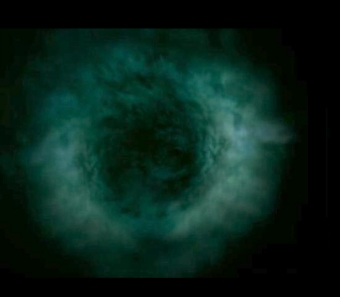|

In Star Trek, a spatial vortex is a wormhole-like
phenomenon that allows rapid travel over great distances. In the Delta
Quadrant, there was a spatial vortex connecting one side of the region
known as the Void to the other. In the 2370s, the Malon Controller Emck
used the vortex to dump antimatter waste in the Void, far from the
Malon home territories. The theta radiation from the waste caused
severe radiation poisoning in the Void's native inhabitants.
In 2375, Captain Kathryn Janeway of the USS Voyager was
determined to destroy the vortex to stop the Malon's pollution of the
Void. With support from the Void aliens, Voyager destroyed Emck's
freighter and fired photon torpedoes as it entered the vortex. As the
vortex collapsed, Voyager jumped into high warp and rode the shock wave
to the other side. (VOY: "Night").
In physics, a vortex is a spinning, often turbulent,
flow of fluid. Any spiral motion with closed streamlines is vortex
flow. The motion of the fluid swirling rapidly around a center is
called a vortex. The speed and rate of rotation of the fluid are
greatest at the center, and decrease progressively with distance from
the center. There are various astrophysical phenomena that are
considered vortices, including the accretion disk of a black hole or
other massive gravitational source. Spiral galaxies (such as our own
Milky Way galaxy) are characterized by a thin, rotating disk. A sunspot
- a dark region on the Sun's surface - is also a vortex, marked by a
lower temperature than its surroundings, and intense magnetic activity.
Hurricane on Earth are vortices marked by a swirling body of clouds and
similar, but far greater, vortices are also seen on other planets, such
as the permanent Great Red Spot on Jupiter and the intermittent Great
Dark Spot on Neptune.
|
|
